Weather Forecasting Satellites—Past, Present, & Future
Abstract
1. Introduction
2. Orbit Classification
- (a)
- High Altitude Platforms (HAPs), including the stratospheric layer (~15–50 km altitude)
- (b)
- Low Earth Orbit (LEO)—approximately 300 to 2000 km altitude
- (c)
- Medium Earth Orbit (MEO)—approximately 4000 to 8000 km altitude
- (d)
- Geostationary Earth Orbit (GEO)—orbiting along the Earth’s equatorial plane at ~35,786 km altitude
- (e)
- Highly Elliptical Orbit (HEO)—elliptical orbits with variable perigee and apogee, often used for extended regional coverage.
3. Satellite Sensor Instrument Technologies
Microwave (MW) Remote Sensors
4. Understanding the Physical Principles of a Meteorological System
- (1)
- The volume scattering coefficient is defined as:
- (2)
- The volume extinction coefficient for clouds is defined as:
- (3)
- The volume backscattering coefficient (also called radar reflectivity) is defined as:for a drop size distribution,the partial concentration of particles per unit volume and increment of variable radius r.
- (4)
- The calculation of the volume extinction coefficient () in the presence of precipitation (such as rain) follows a slightly different approach. It requires considering a specific drop-size distribution that characterizes the number of drops with radius r per unit volume. A well-established model for this purpose was developed by Marshall and Palmer in 1948. Their model, designed for rainfall intensities ranging from 1 to 23 mm/h at the ground surface, provides highly accurate results for estimating rain-induced extinction:where
5. Weather Forecasting Models
5.1. The Next Leap
- (a.)
- Active Ka-Band Radars
- (b.)
- Passive Microwave Radiometers
“Enhanced environmental moisture ahead of a northwestward-moving storm induces a dry air intrusion into the inner core, limiting storm intensification. In contrast, increased moisture in the rear quadrants favors intensification by supplying additional moisture to the inner core and promoting storm symmetry, with primary contributions originating from moisture increases in the boundary layer. The varying impacts of environmental moisture on storm intensification are governed by the relative locations of moisture perturbations and their interactions with the storm’s Lagrangian structure”.[28]
5.2. A Global Measurements Integration Model
- Data Acquisition
- 2.
- Data Transmission to Ground Stations
- 3.
- Cloud-Based Data Processing and Accessibility
- 4.
- Data Processing Using Advanced Forecasting Models
- 5.
- Dissemination to End-Users
6. Profound Impact Potential on Decision-Making Processes
6.1. Modernizing Military Weather Monitoring
6.2. Enhancing National Resilience with the GOES-R Series
- (a)
- Geostationary Lightning Mapper (GLM): Enables continuous real-time lightning detection and tracking.
- (b)
- Solar Ultraviolet Imager (SUVI): Facilitates monitoring of solar activity and space weather conditions.
- (c)
- Compact Coronagraph (CCOR): Provides early detection of coronal mass ejections, helping protect satellites, power grids, and communication systems.
6.3. Leveraging AI for Climate Research
- (a)
- A 15% improvement in accuracy compared to traditional models.
- (b)
- A fourfold increase in geospatial analysis speed, achieved with reduced reliance on labeled training data.
- (c)
- Broad applicability to tasks such as agricultural impact analysis, deforestation monitoring, and wildfire tracking.
6.4. Advances in Solar Weather Forecasting
6.5. China’s Advancements in Meteorological Satellite Constellations
7. Conclusions
Author Contributions
Funding
Data Availability Statement
Conflicts of Interest
References
- Neil deGrasse Tyson Destroys Climate Deniers. Available online: https://www.motherjones.com/environment/2014/05/cosmos-tyson-sagan-climate-change-episode/ (accessed on 15 July 2025).
- Lorenz, E. Glimpses of Chaos. In The Essence of Chaos; University of Washington Press: Seattle, WA, USA, 1995; pp. 6–12. [Google Scholar]
- Lorenz, E. Deterministic Nonperiodic Flow. J. Atmos. Sci. 1963, 20, 130–141. [Google Scholar] [CrossRef]
- Lorenz, E. Our Chaotic Weather. In The Essence of Chaos; University of Washington Press: Seattle, WA, USA, 1995; pp. 77–110. [Google Scholar]
- Vomel, H.; Ingleby, B. Balloon-borne radiosondes. In Field Measurements for Passive Environmental Remote Sensing, 1st ed.; Nalli, N.R., Ed.; Elsevier: College Park, MD, USA, 2022; pp. 23–35. [Google Scholar] [CrossRef]
- Andersson, E.; Sato, Y. WIGOS WMO Integrated Global Observing System—Final Report. In Proceedings of the Fifth WMO Workshop on the Impact of Various Observing Systems on Numerical Weather Prediction, Sedona, AZ, USA, 22–25 May 2012. [Google Scholar]
- Schnee, J.E. Predicting the unpredictable: The impact of meteorological satellites on weather forecasting. Technol. Forecast. Soc. Change 1977, 10, 299–307. [Google Scholar] [CrossRef]
- Turner, B.L.; McCandless, S.R. How Humankind Came to Rival Nature: A Brief History of the Human-Environment Condition and the Lessons Learned. In Earth System Analysis for Sustainability; Schellnhuber, H.J., Crutzen, P.J., Clark, W.C., Claussen, M., Held, H., Eds.; The MIT Press: Cambridge, MA, USA, 2004; pp. 228–243. [Google Scholar] [CrossRef]
- NASA. Tiros 1 Meteorological Satellite System Final Report; NASA Technical Report NASA-TR-R-131; NASA: Greenbelt, MD, USA, 1962; pp. 89–106. Available online: https://ntrs.nasa.gov/citations/19640007992 (accessed on 15 July 2025).
- Sternberg, S. The Post-Launch Performance of the Tiros I Satellite. In Proceedings of the XIth International Astronautical Congress, Stockholm, Sweden, 13–20 August 1960; Reuterswärd, C.W.P., Ed.; Springer: Vienna, Austria, 1961; pp. 330–340. [Google Scholar] [CrossRef]
- Hallgren, R.E. Global Monitoring—Something Old and New. Bull. Am. Meteorol. Soc. 1971, 52, 539–543. [Google Scholar] [CrossRef]
- Grace, D.; Gavan, J.; Tapuchi, S. Concepts and Main Applications of High-Altitude-Platform Radio Relays. Radio Sci. Bull. 2009, 330, 20–31. [Google Scholar]
- Gavan, J.; Tapuchi, S. Microwave Wireless Power Transmission to High-Altitude Platform Systems. Radio Sci. Bull. 2010, 334, 25–42. [Google Scholar]
- Penttinen, J.T.J. Satellite Systems: Communications. In The Telecommunications Handbook: Engineering Guidelines for Fixed, Mobile and Satellite Systems; Penttinen, J.T.J., Ed.; John Wiley & Sons: Hoboken, NJ, USA, 2015; p. 605. [Google Scholar] [CrossRef]
- Stroud, W.G.; Stampfl, R.A. The Automatic Picture Transmission (APT) TV Camera System for Meteorological Satellites; NASA Technical Note NASA-TN-D-1915; NASA: Greenbelt, MD, USA, 1963; pp. 1–6. Available online: https://ntrs.nasa.gov/citations/19630013799 (accessed on 15 July 2025).
- Press, H. Introduction to the Nimbus Meteorological Satellite Program. IEEE Trans. Geosci. Electron. 1970, 8, 241–242. [Google Scholar] [CrossRef]
- Ulaby, F.T.; Long, D.G. Introduction. In Microwave Radar and Radiometric Remote Sensing; Artech House: Boston, MA, USA, 2015; pp. 3–12. [Google Scholar][Green Version]
- Schmugge, T.; O’Neill, P.E.; Wang, J.R. Passive Microwave Soil Moisture Research. IEEE Trans. Geosci. Remote Sens. 1986, 24, 12–22. [Google Scholar] [CrossRef]
- Doviak, R.J.; Zrnic, D.S.; Sirmans, D.S. Doppler weather radar. Proc. IEEE 1979, 67, 1522–1553. [Google Scholar] [CrossRef]
- Ulaby, F.T.; Long, D.G. Microwave Interactions with Atmospheric Constituents. In Microwave Radar and Radiometric Remote Sensing; Artech House: Boston, MA, USA, 2015; pp. 325–360. [Google Scholar][Green Version]
- Doviak, R.J.; ZRNIĆ, D.S. Principles of Radar. In Doppler Radar and Weather Observations, 1st ed.; Elsevier: Alpharetta, GA, USA, 1984; pp. 21–46. [Google Scholar] [CrossRef]
- Kummerow, C.; Barnes, W.; Kozu, T. The Tropical Rainfall Measuring Mission (TRMM) Sensor Package. J. Atmos. Ocean. Technol. 1998, 3, 6–7. [Google Scholar] [CrossRef]
- Yu, F.; Wu, X.; Yoo, H.; Qian, H.; Shao, X.; Wang, Z.; Iacovazzi, R. Radiometric calibration accuracy and stability of GOES-16 ABI Infrared radiance. J. Appl. Remote Sens. 2021, 15, 048504. [Google Scholar] [CrossRef]
- Braun, S.A. TRMM Senior Review Proposal 2011; NASA Global Precipitation Measurement Program: Greenbelt, MD, USA, 2011. Available online: https://gpm.nasa.gov/resources/documents/trmm-senior-review-proposal-2011 (accessed on 15 July 2025).
- Gray, E.; Hanson, H. GPM Mission Brochure; NASA Global Precipitation Measurement Program: Greenbelt, MD, USA, 2014. Available online: https://gpm.nasa.gov/resources/documents/gpm-mission-brochure (accessed on 15 July 2025).
- Lacagnina, C.; Doblas-Reyes, F.; Larnicol, G.; Buontempo, C. Quality Management Framework for Climate Datasets. Data Sci. J. 2022, 21, 1–25. [Google Scholar] [CrossRef]
- Severe Weather Definitions. Available online: https://www.weather.gov/bgm/severedefinitions (accessed on 15 July 2025).
- Wu, L.; Su, H.; Fovell, R.G.; Dunkerton, T.J.; Wang, Z.; Kahn, B.H. Impact of environmental moisture on tropical cyclone intensification. Atmos. Chem. Phys. 2015, 24, 14041–14053. [Google Scholar] [CrossRef]
- Skturud, K.M.; Badts, E.K. Multi-mission Ground Segment as a Service. In Proceedings of the 18th International Conference on Space Operations, Montreal, QC, Canada, 26–30 May 2025; SpaceOps: Montreal, QC, Canada, 2025. [Google Scholar]
- Bouallègue, Z.B.; Clare, M.C.A.; Magnusson, L. The Rise of Data-Driven Weather Forecasting: A First Statistical Assessment of Machine Learning-Based Weather Forecasts in an Operational-Like Context. Bull. Am. Meteorol. Soc. 2024, 105, 864–883. [Google Scholar] [CrossRef]
- Fan, D.; Greybush, S.J.; Clothiaux, E.E.; Gagne, D.J., II. Physically Explainable Deep Learning for Convective Initiation Nowcasting Using GOES-16 Satellite Observations. Artif. Intell. Earth Syst. 2024, 3, e230098. [Google Scholar] [CrossRef]
- Blackwell, W.J.; Chen, F.W. Neural Networks in Atmospheric Remote Sensing; Artech House: Boston, MA, USA, 2009; pp. 2–3. [Google Scholar]
- Raytheon Intelligence & Space. AWIPS System Manager’s Manual: AWIPS II Operational Build; NOAA: Silver Spring, MD, USA, 2022. Available online: https://vlab.noaa.gov/web/awips-technical-library/document-library?p_p_id=com_liferay_document_library_web_portlet_DLPortlet&p_p_lifecycle=0&p_p_state=normal&p_p_mode=view&_com_liferay_document_library_web_portlet_DLPortlet_mvcRenderCommandName=%2Fdocument_library%2Fview_file_entry&_com_liferay_document_library_web_portlet_DLPortlet_redirect=https%3A%2F%2Fvlab.noaa.gov%3A443%2Fweb%2Fawips-technical-library%2Fdocument-library%3Fp_p_id%3Dcom_liferay_document_library_web_portlet_DLPortlet%26p_p_lifecycle%3D0%26p_p_state%3Dnormal%26p_p_mode%3Dview%26_com_liferay_document_library_web_portlet_DLPortlet_mvcRenderCommandName%3D%252Fdocument_library%252Fview_folder%26_com_liferay_document_library_web_portlet_DLPortlet_folderId%3D22933652&_com_liferay_document_library_web_portlet_DLPortlet_fileEntryId=22933559 (accessed on 15 July 2025).
- Mun, J.; Ford, D.N.; Housel, T.J.; Hom, S. Measuring the Return on Investment and Real Option Value of Weather Sensor Bundles for Air Force Unmanned Aerial Vehicles. In Proceedings of the Naval Postgraduate School Acquisition Research Symposium, Monterey, CA, USA, 4–5 May 2016; Available online: https://dair.nps.edu/handle/123456789/15 (accessed on 15 July 2025).
- Next-Gen Weather Satellite Set to Enhance Global Military Operations. Available online: https://www.spacedaily.com/reports/Next_Gen_Weather_Satellite_Set_to_Enhance_Global_Military_Operations_999.html (accessed on 15 July 2025).
- Space Force Launches Weather Satellite to Replace 1960s-Era Spacecraft. Available online: https://www.c4isrnet.com/battlefield-tech/space/2024/04/11/space-force-launches-weather-sat-to-replace-1960s-era-spacecraft/#:~:text=%E2%80%94%20The%20Space%20Force%20on%20Thursday,a%20SpaceX%20Falcon%209%20rocket (accessed on 15 July 2025).
- Rain or Shine: Why Upgraded Space-Based Weather-Monitoring is Crucial for the Military. Available online: https://breakingdefense.com/2023/11/rain-or-shine-why-upgraded-space-based-weather-monitoring-is-crucial-for-the-military/ (accessed on 15 July 2025).
- Increasing National Resilience with Cutting-Edge Weather Satellite Technology. Available online: https://spaceproject.govexec.com/sponsors/sponsor-content/2024/06/increasing-national-resilience-cutting-edge-weather-satellite-technology/397027/ (accessed on 15 July 2025).
- Chapel, J.; Stancliffe, D.; Bevacqua, T. Guidance, navigation, and control performance for the GOES-R spacecraft. CEAS Space J. 2015, 7, 87–104. [Google Scholar] [CrossRef]
- SpaceX Launches NOAA’s Monumental GOES-U Mission Claiming: The Nation’s Most Advanced Weather Observing and Environmental Monitoring SATELLITE System. Available online: https://news.satnews.com/2024/06/25/spacex-launches-noaas-monumental-goes-u-mission-claiming-the-nations-most-advanced-weather-observing-and-environmental-monitoring-satellite-system/ (accessed on 15 July 2025).
- NASA and IBM Research Apply AI to Weather and Climate. Available online: https://www.earthdata.nasa.gov/news/blog/nasa-ibm-research-apply-ai-weather-climate (accessed on 15 July 2025).
- Modeling Solar Weather Better and Faster for Decision Advantage. Available online: https://www.airandspaceforces.com/modeling-solar-weather-better-and-faster-for-decision-advantage/ (accessed on 15 July 2025).
- Xu, X.; Han, W.; Wang, J.; Gao, Z.; Li, F.; Cheng, Y.; Fu, N. Quality assessment of YUNYAO radio occultation data in the neutral atmosphere. Atmos. Meas. Tech. 2025, 18, 1339–1353. [Google Scholar] [CrossRef]
- Guan, M.; Wang, J.; Zhao, X.; Qin, D.; Fan, C.; Xian, D.; Liu, C. Progress and Achievements of Fengyun Meteorological Satellite Program since 2022. Chin. J. Space Sci. 2024, 4, 712–721. [Google Scholar] [CrossRef]
- Maintaining a Functional Meteorological Satellite Program for National Defense. Available online: https://www.americansecurityproject.org/maintaining-a-functional-meteorological-satellite-program-for-national-defense/ (accessed on 15 July 2025).
- NOAA Eyes Replacing Ageing Network of WSR-88D NEXRAD Weather Radar to Warn of Tornadoes and Thunderstorms. Available online: https://www.militaryaerospace.com/sensors/article/55139014/weather-radar-enabling-technologies-tornadoes-and-thunderstorms (accessed on 15 July 2025).
- GOES-R: Understanding the Critical Role of Weather Satellites. Available online: https://aerospace.org/article/goes-r-understanding-critical-role-weather-satellites. (accessed on 15 July 2025).
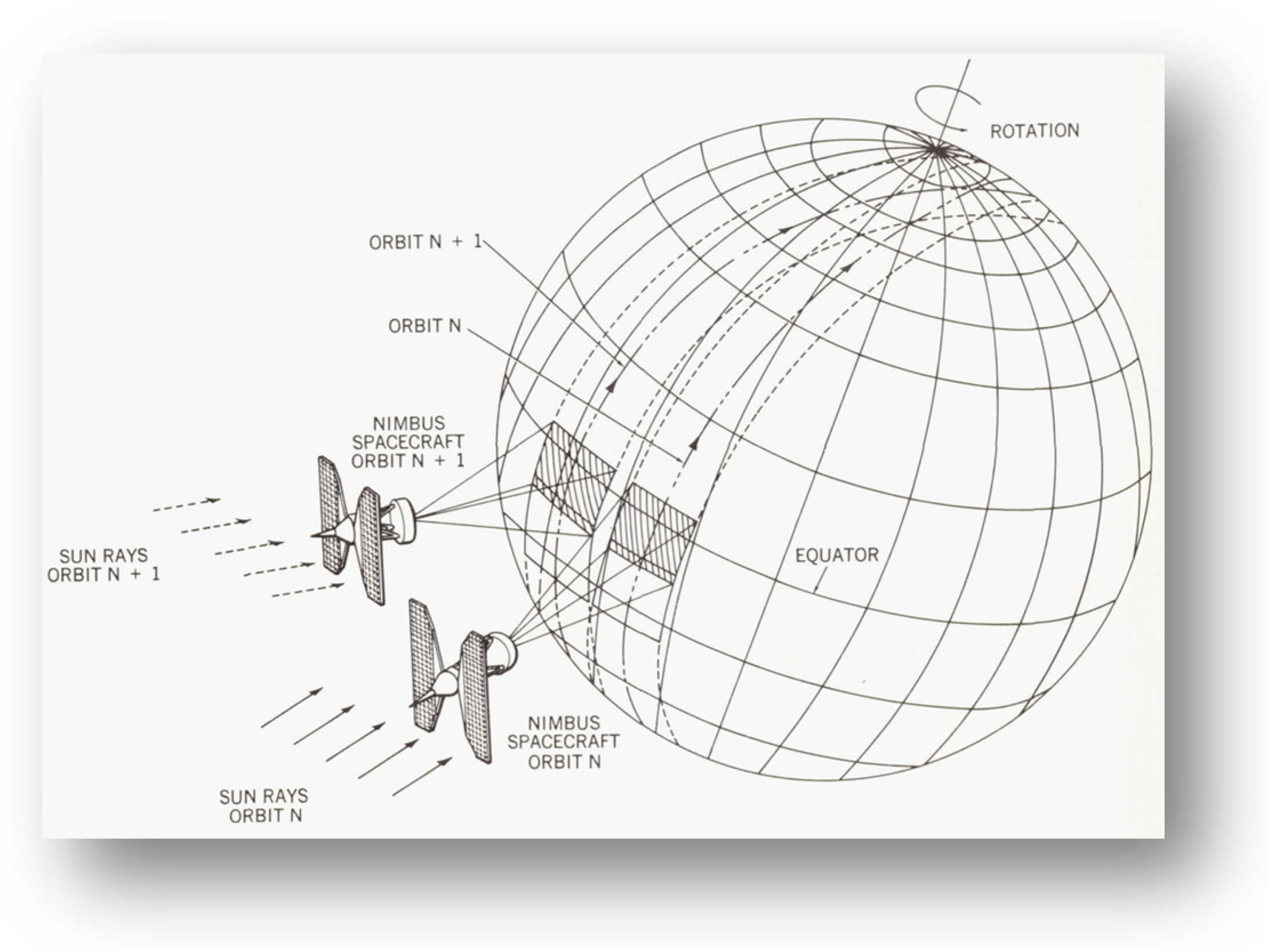
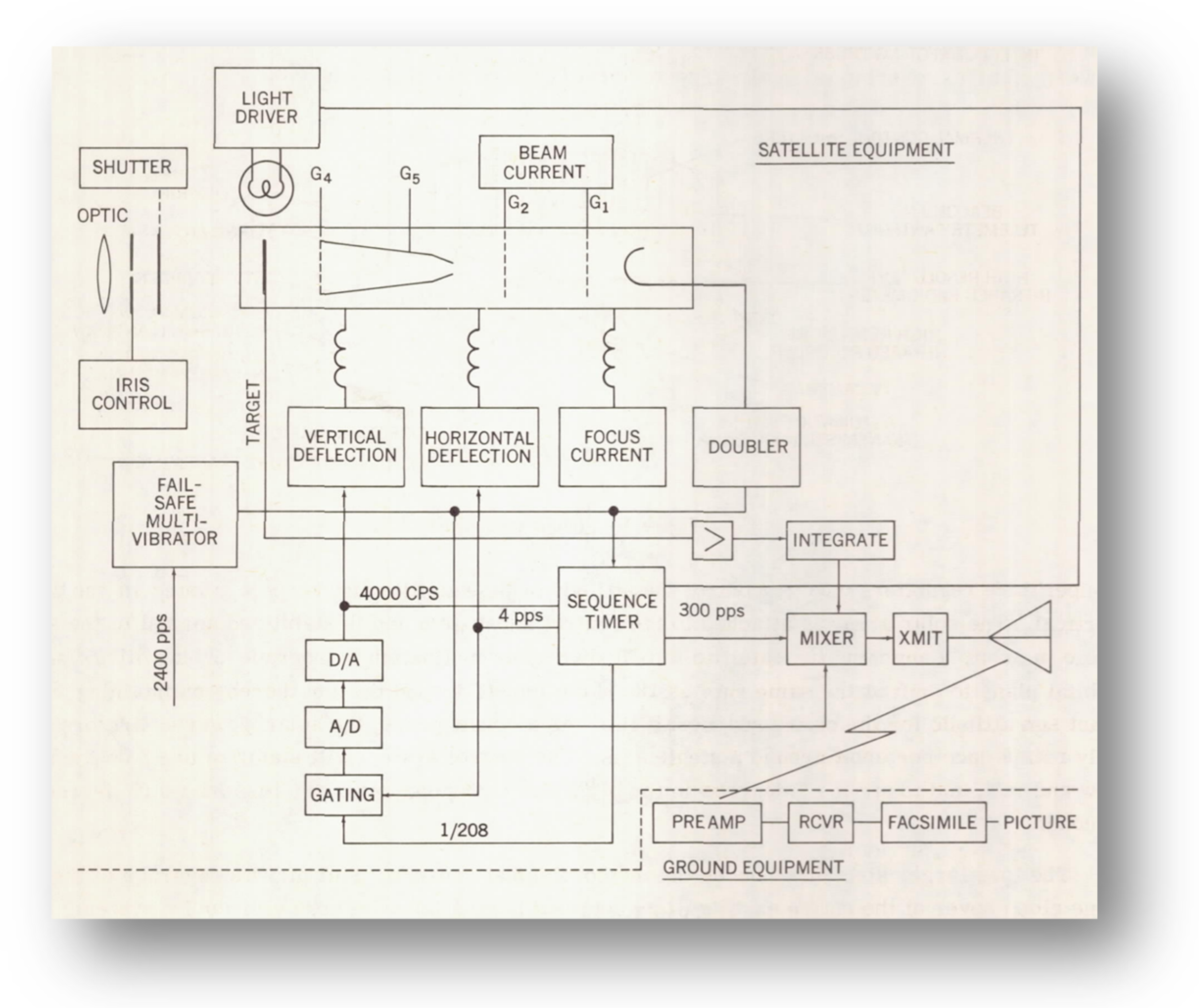
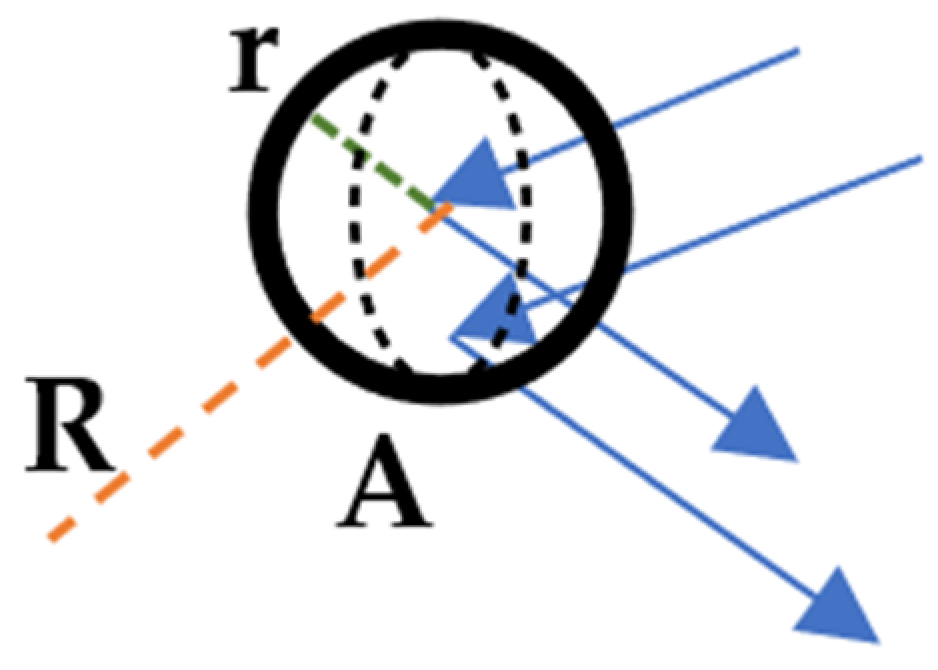
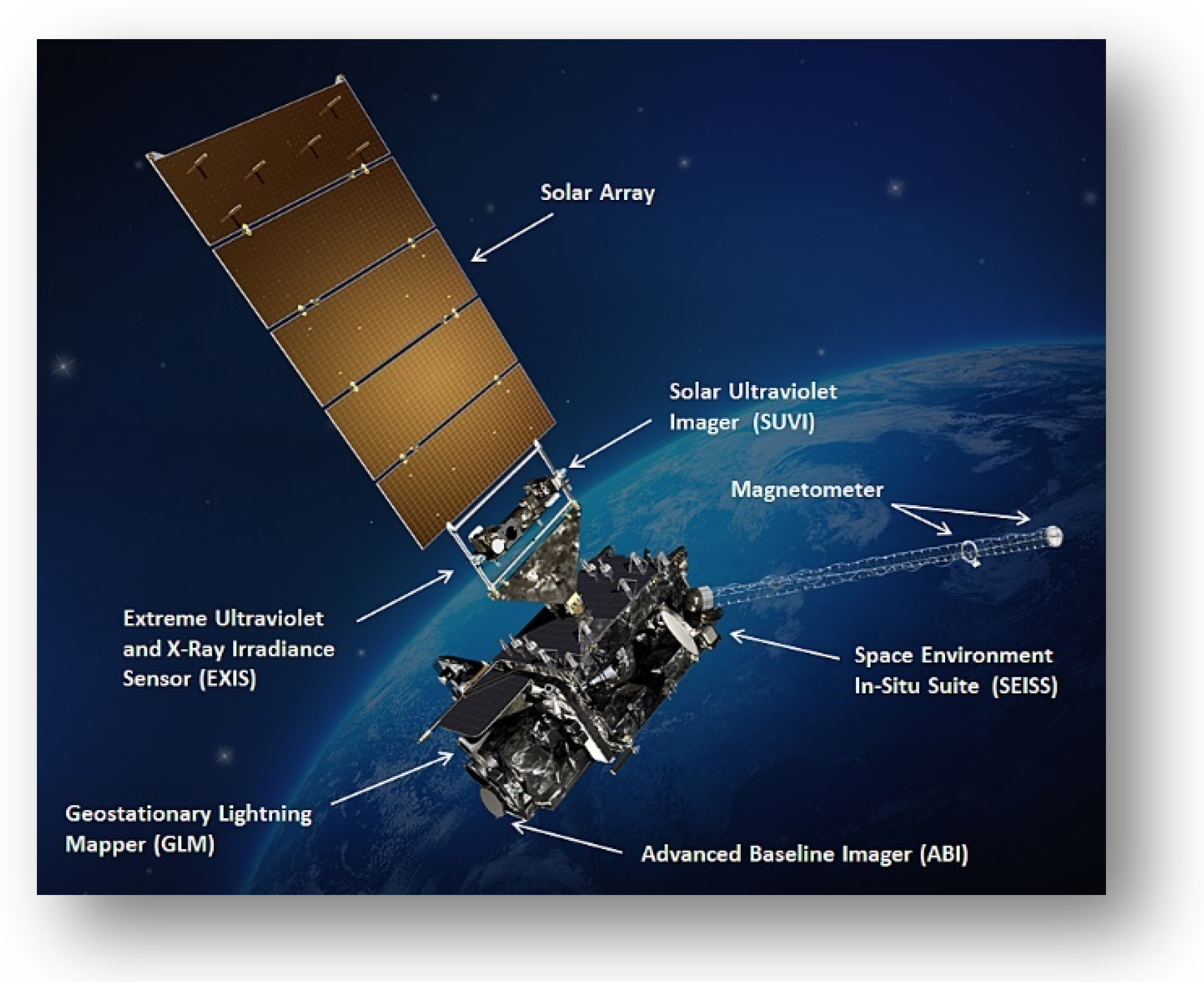

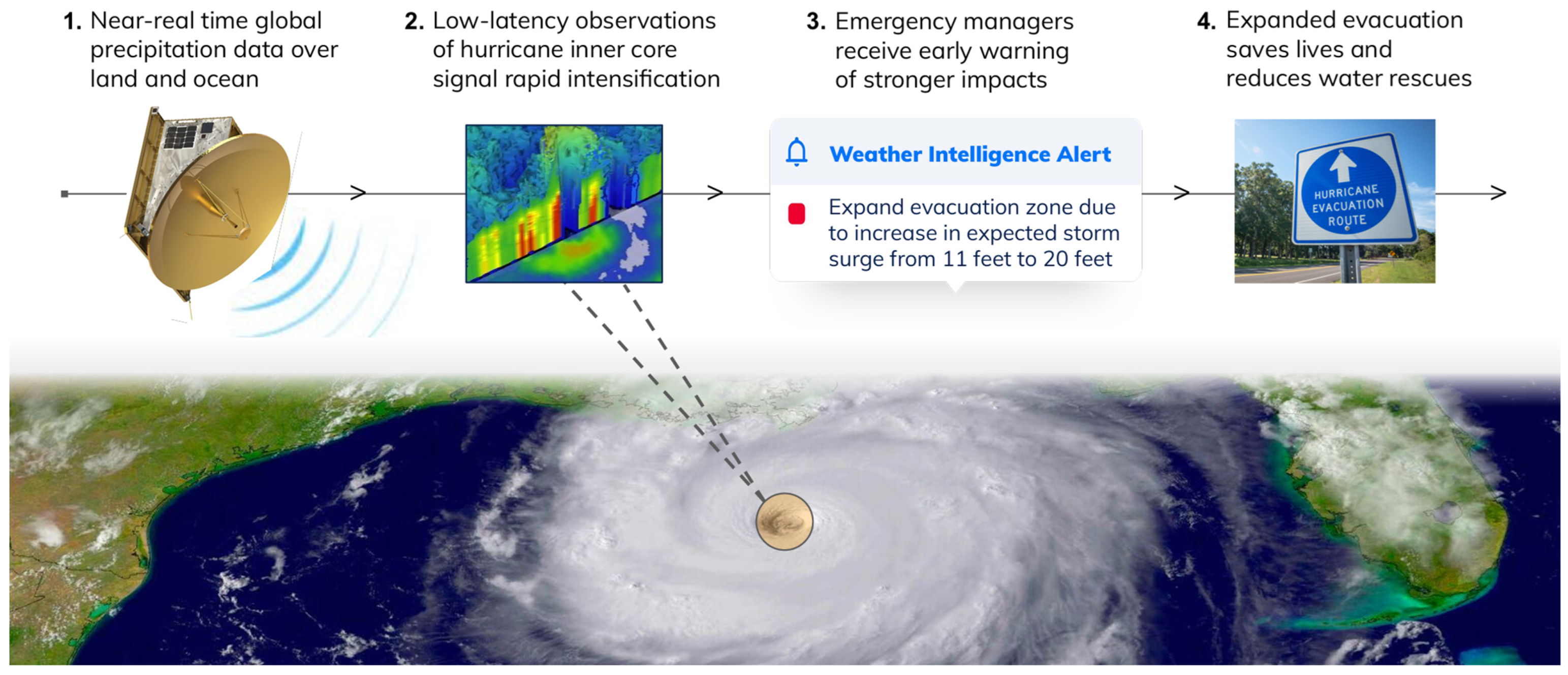
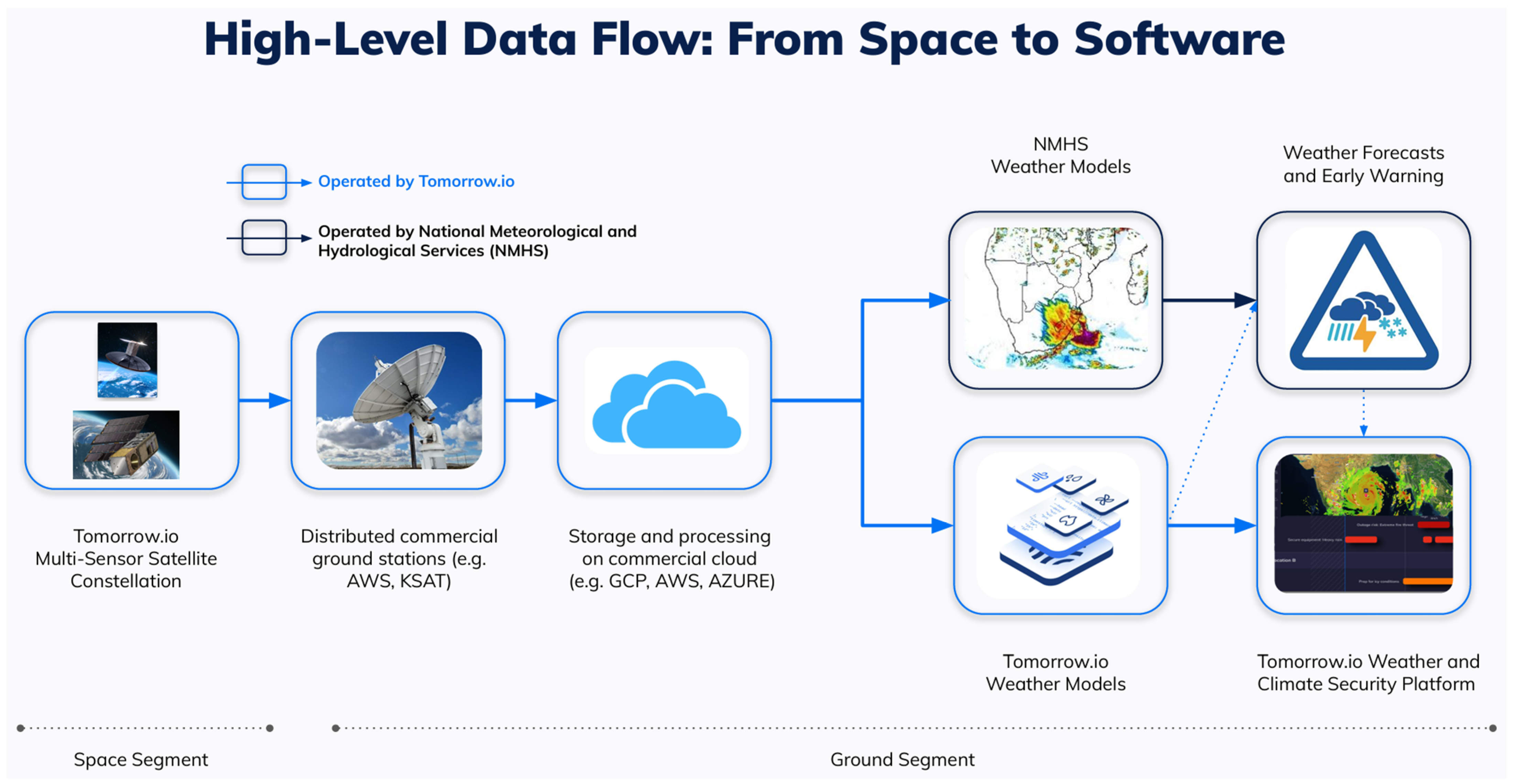
| Satellite System | Revisit Rate | Date of Operation |
|---|---|---|
| TRMM | 3 days | 1997–2015 |
| CloudSat | 16 days | 2006–2024 (decommissioned) |
| GPM | 3 days | 2014–2028 |
| RainCube | Limited | 2018–2021 |
| EarthCare | 16 days | 2023 |
| INCUS | Limited | Start—2027 |
Disclaimer/Publisher’s Note: The statements, opinions and data contained in all publications are solely those of the individual author(s) and contributor(s) and not of MDPI and/or the editor(s). MDPI and/or the editor(s) disclaim responsibility for any injury to people or property resulting from any ideas, methods, instructions or products referred to in the content. |
© 2025 by the authors. Licensee MDPI, Basel, Switzerland. This article is an open access article distributed under the terms and conditions of the Creative Commons Attribution (CC BY) license (https://creativecommons.org/licenses/by/4.0/).
Share and Cite
Nardi, E.; Cohen, O.; Pinhasi, Y.; Haridim, M.; Gavan, J. Weather Forecasting Satellites—Past, Present, & Future. Information 2025, 16, 677. https://doi.org/10.3390/info16080677
Nardi E, Cohen O, Pinhasi Y, Haridim M, Gavan J. Weather Forecasting Satellites—Past, Present, & Future. Information. 2025; 16(8):677. https://doi.org/10.3390/info16080677
Chicago/Turabian StyleNardi, Etai, Ohad Cohen, Yosef Pinhasi, Motti Haridim, and Jacob Gavan. 2025. "Weather Forecasting Satellites—Past, Present, & Future" Information 16, no. 8: 677. https://doi.org/10.3390/info16080677
APA StyleNardi, E., Cohen, O., Pinhasi, Y., Haridim, M., & Gavan, J. (2025). Weather Forecasting Satellites—Past, Present, & Future. Information, 16(8), 677. https://doi.org/10.3390/info16080677







